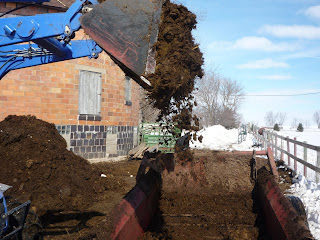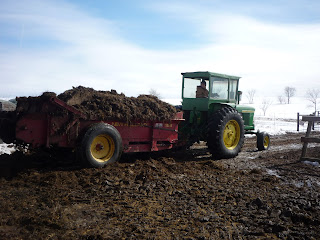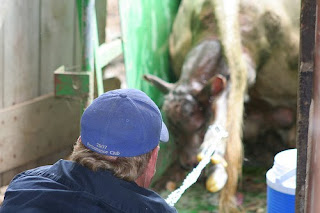because this Christmas letter is long. (Why aren’t you surprised at that?)
So go grab yourself a cup of tea, sit back and enjoy…and have a happy New Year!!
As I sit down to write this, there’s a sign for our egg customers on the barn door that reads, “Skunk Attack! Eggs are in the House.”
A week ago, I tried to unhook the snow blade from the back of the tractor but had the support stand in the wrong place. The blade fell forward, got stuck on the tractor hitch and Mark Highland had to rescue me.
A few months ago, our grain-fed steers got loose and wandered over to a farm about a mile away. We’d never met these people before, but proceeded to spend 4 long days there trying to get the cows out of their soybean and corn fields.
Farming is an excellent lesson in humility!
We’ve made progress, that’s for sure, but our successes have occurred only after many spectacular failures, embarrassments or desperate pleas for help. If it weren’t for my inborn Irish stubbornness and my superbly capable husband, I would have thrown in the towel long ago. We have learned a lot in the past few years, though, and we’ve come a long way since that fateful spring when we found ourselves with a farm to run and no idea how to run it.
For instance, we have a solid base of egg customers and a long list of people waiting to buy our grass-fed beef. Selling directly to consumers keeps us from feeling too isolated out here in the sticks, gives us better price control for our products, and can also be pretty hilarious. Recently a woman called to say she was coming for 3 dozen eggs the next day. When I told her I didn’t have any saved and that the hens are only laying a dozen and a half per day, she replied, “Well, I’d like 3 dozen. I’ll be there in the morning.” I wondered if she thought I had a hotline to the barn, “Ladies, ramp it up in there. We’ve got a big order to fill!”
People’s desire to be more closely connected to their food source is real, though. We try to honor that desire by answering questions, welcoming people to the farm, and doing our best to ensure a high quality product. There is no doubt that we’ve benefited immensely from the renewed interest in local foods and we feel very fortunate that these people have decided to support us.
2009 was a good grazing year. The cattle herd was finally big enough to utilize our pasture and moving temporary fences every few days presented a good occasion to walk amongst the cows, check on pasture conditions, and test the strength of the electric charge (ouch!). Calving was challenging, to say the least. Of 17 pregnant cows, we had 10 first-time mothers, 4 of whom ended up needing birthing assistance. Scott Swanson was gracious enough to be “on call” for us, and Laura and Rob even got the opportunity to pull one (with Scott’s help) while we were in Eagle River for our annual Peace Corps reunion. By the 4th calf, though, Marcel and I felt confident enough to try it on our own. We were thrilled when we successfully pulled the calf and he survived.
Like most farms, we had a tough year for crops. High input costs, a cool, wet summer, and a very wet fall made for the perfect storm: lower yields, lower test weights, high moisture counts and a difficult harvest. I think the wet harvest hit the guys the hardest, though–Marcel, Rob and Matt were all disappointed that they didn’t get to load the grain bin this year. The harvest wasn’t the same without the hustle and bustle of moving wagons.
Finally, 2009 brought one more addition to the farm–Mom’s new husband Gordy. We understand why Gordy fell in love with Mom (she is wonderful after all), but we do wonder if he had his head on straight when he agreed to move out to the farm. In the past year he has been roped into more cattle round-ups, fence moves, childcare ventures and boring farm discussions than he probably ever thought possible. And being the Flynn’s that we are, we aren’t prone to pass up the opportunity to put an able-bodied individual to work! So we welcome him to the fold and apologize in advance.
We know there will be more farm adventures in the New Year, surely more mistakes and hopefully more successes as well. We thank you for your love, support, and especially if you’re a local farmer, patience over the past year.
All of us at Irish Grove Farms wish you and yours a very Merry Christmas and Happy New Year!
Jackie & Marcel, Laura & Rob, Matt, Marcia & Gordy,
the kids, dogs, cats, horses, goats, chickens, and cows. (Phew!)






















